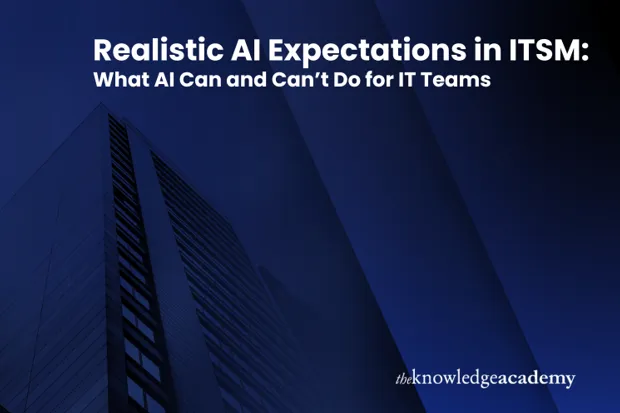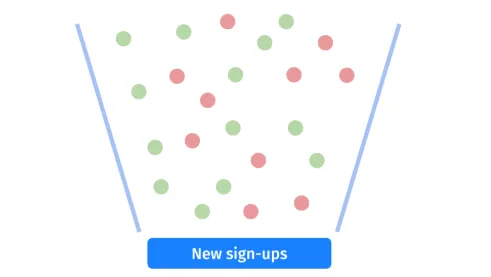Realistic AI Expectations in ITSM: What AI Can and Can’t Do for IT Teams
AI is everywhere—powering customer support chatbots, automating business processes, and even predicting the next big tech trends. But when it comes to IT Service Management (ITSM), can AI truly revolutionise the way IT teams work?
Many organisations are now looking into Agile IT Service Management Courses to better understand how to integrate AI with ITSM frameworks. The goal is to combine agility with automation, ensuring IT teams can respond faster while maintaining efficiency. However, despite these advancements, there are still misconceptions about AI’s role in ITSM.
Many businesses invest in AI-powered ITSM Tools, hoping to eliminate service desk backlogs, reduce downtime, and create a seamless IT experience. But what is the reality? AI is a powerful assistant, not a magic wand. In this blog, we’ll explore what AI can and can’t do in ITSM, helping you set realistic expectations for integrating AI into IT service operations.
The Role of AI in ITSM
Before diving into its capabilities and limitations, let’s first understand how AI is used in modern ITSM:
- AI-Powered Chatbots: AI-driven virtual agents provide round-the-clock support by handling common IT queries.
- Automated Ticketing Systems: AI can categorise, prioritise, and route tickets to the right teams based on predefined rules and historical data.
- Predictive Analytics: AI helps IT teams anticipate potential system failures by analysing historical incidents.
- Incident Management: AI can detect and escalate critical issues before they impact business operations.
- Self-Healing IT Systems: AI can trigger automated responses to fix minor issues without human intervention.
While these features enhance ITSM efficiency, it’s important to understand where AI shines and where human expertise remains essential.
What AI Can Do for IT Teams
AI is undoubtedly a game-changer in ITSM. Here’s where it excels:
1. Automate Repetitive Tasks
IT teams often deal with routine, time-consuming tasks like password resets, software updates, and system health checks. AI can automate these processes, freeing IT professionals to focus on complex problem-solving.
2. Improve Incident and Problem Management
AI-driven predictive analytics can identify potential issues before they escalate. By analysing historical data, AI can spot patterns in system failures, allowing IT teams to proactively resolve issues before they disrupt business operations.
3. Enhance IT Support with AI Chatbots
AI chatbots provide instant support for basic IT queries, such as troubleshooting common software issues or guiding users through FAQs. This reduces the workload for IT service desks while improving response times.
4. Optimise IT Workflows and Ticket Prioritisation
AI helps classify and prioritise tickets based on urgency, impact, and user history. Instead of following a manual queue, AI-driven systems ensure that critical incidents receive immediate attention, while minor issues are resolved in due course.
5. Assist in IT Decision-Making
AI-powered ITSM dashboards provide real-time insights into system performance, incident trends, and resource utilisation. IT leaders can use this data to make smarter, data-driven decisions about infrastructure, staffing, and process improvements.
While these capabilities sound impressive, AI still has significant limitations. Let’s explore where AI falls short in ITSM.
What AI Can’t Do for IT Teams
Despite its advancements, AI is not a silver bullet for ITSM challenges. Here’s where its limitations become clear:
1. AI Can’t Replace Human IT Professionals
AI excels at automation and pattern recognition, but it lacks human intuition, creativity, and strategic thinking. IT service management involves critical problem-solving, negotiation, and customer interaction, which AI simply cannot replicate.
2. AI Is Not 100% Accurate
AI-powered ticketing systems and chatbots rely on machine learning models, which can sometimes misinterpret user requests. This leads to incorrect classifications, escalating the wrong tickets, or providing generic responses that frustrate users.
3. AI Can’t Fully Understand Context and Emotions
AI chatbots and virtual assistants may misinterpret complex queries that require contextual understanding. Unlike human IT agents, AI lacks emotional intelligence, making it less effective in handling frustrated users or high-stress situations.
4. AI Requires High-Quality Data
AI’s effectiveness is only as good as the data it is trained on. If an organisation has incomplete, outdated, or biased data, AI-powered ITSM tools may generate incorrect predictions or automate processes inefficiently.
5. AI Struggles with Unstructured Problems
AI is designed to handle structured, repetitive tasks, but ITSM often involves unique, unpredictable challenges. Major incidents, security breaches, and multi-system failures require human decision-making and experience to resolve effectively.
Setting Realistic AI Expectations in ITSM
To successfully integrate AI into ITSM, organisations must adopt a balanced approach. Here’s how:
- Use AI as an Assistant, Not a Replacement: AI should enhance ITSM efficiency, not eliminate human involvement. IT professionals should work alongside AI, leveraging automation where it makes sense.
- Invest in AI Training and Governance: Teams need to understand how AI works, its limitations, and how to manage AI-driven processes effectively. AI governance ensures transparency and ethical use.
- Improve Data Quality for AI Accuracy: AI is only as good as its data—organisations must maintain clean, high-quality datasets to improve AI predictions and automation.
- Balance Automation with Human Oversight: AI should handle routine ITSM tasks, but complex and critical incidents must always involve human decision-makers.
Conclusion
AI in ITSM is evolving, but it’s not an all-in-one solution for IT service management challenges. While AI can automate tasks, enhance workflows, and optimise decision-making, it can’t replace human expertise, creativity, or complex problem-solving.
As organisations continue to adopt AI-powered ITSM tools, those who strike the right balance between automation and human oversight will experience the best results. So, is your IT team ready to embrace AI the right way? Start your journey with The Knowledge Academy.







